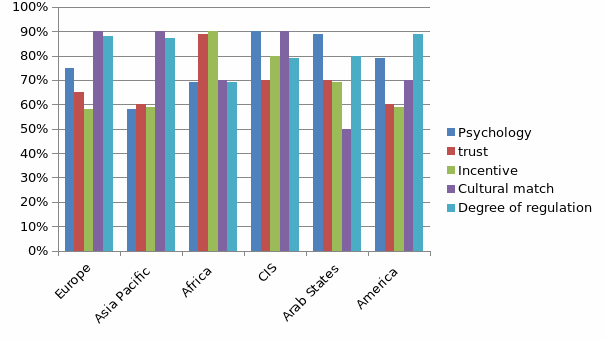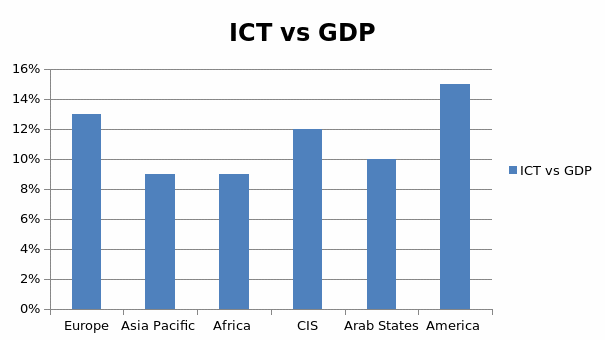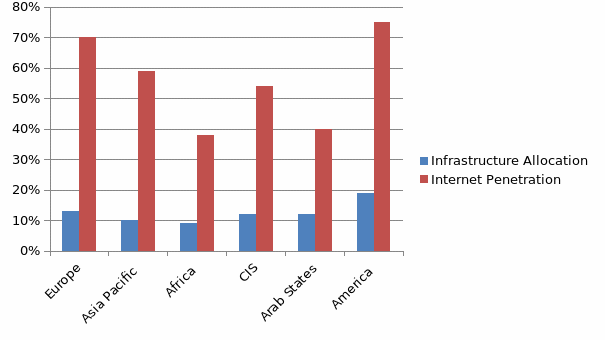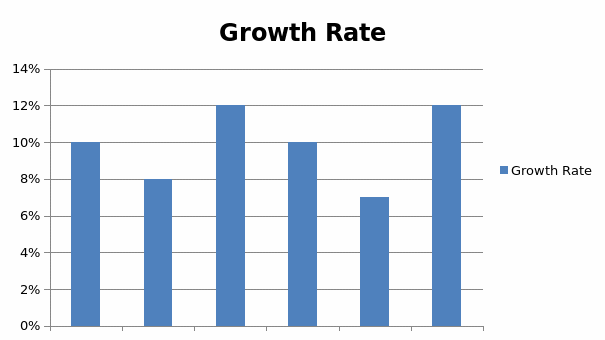Introduction
Critical mass refers to a certain level of buyers and sellers that has capability to attract other buyers and sellers in the eMarketplace. Critical mass is an important feature in the success of any eMarketplace, with its growth speed and users seen as the crucial success metric. McGrew states that critical mass “implies self-sustaining chain reactions.” 25
This reaction causes synergistic effects that would sustain the present prosperity for long. E-marketplaces can be defined as electronic intermediaries that bring together sellers and buyers. There has been tremendous growth of activity over the internet in the last 15 years.
Considering different regions of the world including America, Arab States, Commonwealth of Independent States (CIS), Africa, Asia Pacific, and Europe, this paper investigates the critical success factors that can result in achievement of the critical mass of eMarketplaces and to what extent each factor might affect the previously mentioned world regions. 12 Online shopping have grown tremendously over the years.
Hence, considerable interest has been aroused among many researchers. The researchers have been keen to determine the relationship between online shopping environments and consumer choice, Internet shopping as a channel to enable product distribution and factors that enhance or reduce online shopping. The researchers have also studied the possible relationships between online shopping and price movements.
Online retailers competing among themselves and against the traditional brick and mortar stores have also developed interest to explore consumer motivation that makes them to shop online. The growth in online shopping has also coincided with the excellent uptake of internet usage by young adults.
Literature Review
There are different factors that influence utilization of eMarketplaces. Previous studies indicate six major factors: Psychology of consumers, Consumer Trust, Incentive offered by eMarketplaces’ players, Cultural Match, Degree of regulation in the host country. 11
A study conducted in Saudi Arabia confirmed these factors and highlighted the importance of each in building a critical mass in eMarketplaces. However, these are not the entire factors that results in building of critical mass in eMarketplaces. 10
The following figure indicates the level of influence of the above factors in consumer decision making in the aforementioned regions.
Table 1 Level of Influence in different Regions
Summary of incentives and level of influence in different regions

Figure 2 Graphic Comparison of Influence of Factors
The above table and figures indicate that the level of influence varies from one region to another. Authors attribute this disparity to infrastructure levels, level of education, emphasis of spending on ICT by governments, internet penetrations among other factors not within the control of the consumer.
The figure below gives a hint of how these factors influence achievement of the critical mass of eMarketplaces by looking at the ratio of average governments’ spending in different regions. 13

Figure 3 Spending on ICT vs. GDP in Different Regions
Proposed Explanatory Model
The explanatory model is based on five hypotheses. It suggests that the model in Figure 1 above affects utilization of eMarketplaces. However, each factor affects the consumers of the various regions to a different level. The resultant model has the capability to explain achievement of critical mass in eMarketplaces in only one region at a time.
The model assumes the nature of a regression model whereby the dependent variable is the critical mass of eMarketplaces and the independent variables are Psychology of consumers, Consumer Trust, Incentive offered by eMarketplaces’ players, Cultural Match, Degree of regulation in the host country. 26
Previous researches indicate that these factors affect the formation and development of the critical mass as proposed by Metcalfe Law (Value of eMarketplace increases as the square of the number of member’s increases). However, the model can only be applied independently in each of the regions and comparisons made. 14
Research Method and Data Collection
This section looks at the different regions and analyzes data relating to the different factors to come up with models that explain consumer behavior. The section below will analyze the different factors in relation to the various regions and underpin how they influence consumer behavior and to what level with explanations for each. 15
Psychology
Psychology of consumers can lead to the critical mass of eMarketplaces. This hypothesis is true based on the finding in the literature review. 27 It is evident from the review that if a seller gets to understand the buyer well, and create products based on this understanding, then it is easy to attract a critical mass. The online shopping context was characterized by consumers seeking variety seeking and motivated by convenience.
However, the offline shopper was more motivated by timesaving and recreation when compared to the typical online shopper. 3 Therefore, these factors may be used in differentiating shopping types across these channels and in developing a model of online shopping motivation.
The research also contributes to knowledge of Internet marketing. The study’s findings posit that consumers motivated by convenience are likely to shop online for specific goods and services. Retailers should therefore seek to develop strategic alliances for such products and services.
Variety seekers and balance buyers, on the other hand, are attracted by the internet’s search and comparison ability. Marketers should therefore seek ways to reduce the delivery time to consumers to attract more store-oriented consumers. 4
The study of the effects of intrinsic and extrinsic motivations also resulted evidence contrary to previous assumptions that online shopping was goal oriented. Intrinsic motivations were found to be the primary motivations for online shopping while extrinsic motivations were not major. 24 This was true for models explaining online shopping intensity and the decision on whether to shop online or not.
While perceived usefulness was not a primary reason for users to shop online, perceived ease of use was directly related to the uptake of IT solutions and intrinsic motivation. 16 Worries over the users’ network security and uncertainty about online sales process were also acted as obstacles to online shopping.
The association between online shopping and fashion involvement was also found to be strong. This has indeed kindled the research on the role of intrinsic motivation on consumer actions. A second possible area of research is the role of extrinsic motivation in consumer choice influence by retailers. 5
Trust
Sellers should develop appropriate ways of providing product and service information and find ways to vend goods effectively goods and services on However trivial the relationship between motivations and internet usage seem, they are still relevant. Vendors of products online should also strive to increase the interactivity of their WebPages to increase consumer interactive control motivations.
A consumer will also derive great satisfaction from using the online solution offered. Social interaction motivations are also real for online businesses. Vendors should encourage the development of social relationships with their customers. Loyalty points and customer feedback analysis are a major way of implementing this. 7
The consumers’ propensity to pay higher prices online was found to be a factor of various perceptions. Consumers’ perceptions of quality and value increased while perceptions of sacrifice decreased with higher information loads. Higher information loads also led to decreased perceptions of quality and value and increased perceptions of sacrifice for the low price level products and services. 22
Therefore, consumers are more likely to pay higher prices if they have a higher perception of value and favorable view towards the product. Ideal information load results in a low perception of sacrifice and a high perception of value. Online retailers must therefore aim to represent their products in such a way that low price will not be associated with low sacrifice rather low quality.
They should balance between information loads to increase their products exposure. They can do this by accurate market targeting using recent technology. 8
Incentive
Online retailers should display their products in a way that encourages role enactment motivation. The web sites should consequently evoke utilitarian perceptions. Traders should exploit the differences between adolescents and adults’ shopping motivation to make sales. 23
Adolescents shopping motivations are strongly related to shopping perceptions except for the economic utility motivation. There is a positive relationship between hedonic perception and social interaction and emotional utility and another positive relationship between utilitarian perception and motivations of sensory stimulation, role enactment, and choice optimization. 9
Cultural Match
Cultural Match influences the critical mass of eMarketplaces according to previous research as noted in Literature Review. 19 Taking into consideration the culture of different audiences in drafting a product encourage them to carry out purchases in the eMarketplace.
Culture refers to the way of living, values, and beliefs of a certain group of people. Achieving critical mass in eMarketplaces requires that producers of online goods and activity focus on this critical factor. 2
Degree of Regulation
Degree of regulation affects the critical mass of eMarketplaces according to previous research. Regulation brings sanity in the eMarketplace and aids in creating order hence leading to a critical mass. 17
However, too much regulation may forestall creation of critical mass. It is imperative for the governments to understand the level, which may lead to lack of innovation and strive to work with an optimum level of regulation. This way achievement of critical mass is made easier and fostered. 1
Results and Findings
The above analysis indicates that achievement of critical mass of eMarketplaces is a joint effort between different stakeholders. 20 However, the biggest stakeholder is government.
The following are some of the areas that governments contribute towards in growth of eMarketplaces. The first is infrastructure. The table below indicates average percentages of infrastructure allocation and level of internet penetration in different regions. 21

The following model can explain the resultant model that explains the achievement of critical mass in eMarketplaces.
Y= a*psychology+b*trust+c*incentive+d*cultural match+e*degree of regulation
This shows a regression model with different values for a, b, c, d, and e.
At an average of 82%, degree of regulation that different governments impose on citizens regarding internet usage was the greatest influence across regions in achievement of critical mass. It follows that governments have a crucial role to play in fostering growth of the internet in host countries. This is the same case in infrastructure allocations noted above.
The internet has been growing at an almost steady rate in these six regions over the last couple of years as indicated in the figure below.

In achieving critical mass for eMarketplaces, the six major factors indicated above were considered. The following table indicates each regions performance on those factors.
The research findings indicate, as stated in the literature review, it is evident that cultural match, degree of regulation, psychology, trust and incentives have a large part to play in creating a critical mass. When employed correctly, these features could see an increase in the number of buyers on the eMarketplace. The resultant model is of regression nature.
Conclusion and Future Works
Research findings show that when eMarketers employ these factors in the right way, people will be attracted to the site thus creating a critical mass that will translate into sales. Understanding the psychology of the buyers is also a crucial component in increasing online purchasing since it helps in guiding the sellers on how to package their products to best suit the buyers.
It is also notable that incorporating cultural match and incentives could help in attracting the buyers since they will have a sense of belonging in relation to the eMarketplace and as such resort to online purchasing. 17
The researcher, however , suggest that further studies be carried out to help dictate the appropriate degree of regulation that should be employed to allow the buyers get full satisfaction with the services provided as well as make the seller not feel held back in information delivery.
In addition, studies should be carried out on how to improve cultural balance in the advertising of products so that no market is left out in the selling of online goods. Further research on best incentives and reward processes should also be made to come up with sensible and attractive packages for both the sellers and the buyers. 18
Reference List
1. Krishnamurthy S. Contemporary Research in E-Marketing, Volume 2. Idea Group Publishing. USA. 2006.
2. Pennanen K. The Initial Staged of Consumer Trust Building in E-commerce. University of Vaasa. 2009.
3. Brogan C, Smith J. Trust gents: Using the Web to Build Influence, Improve Reputation, and Earn Trust. John Wiley &Sons, New Jersey. USA. 2010.
4. Karake-Shalhoub Z. Trust and Loyalty in Electronic Commerce: An Agency Theory Perspective. Greenwood publishing Group. USA. 2002.
5. Jansson-Boyd C. Consumer Psychology, Open University Press. New York. USA. 2010.
6. Yuan Gao. Web Systems Design and Online Consumer Behavior. Idea Group Publishing. USA. 2005.
7. Pride W, Ferrel O. Marketing 2012. South-Western Cengage Learning. USA. 2012.
8. Haugtvedt C, Machleit K, Yalch R. Online Consumers Psychology: Understanding and Influencing Consumer Behavior in the viral World. Lawrence Erlbaum Associates, Inc. USA. 2005.
9. Barrat C, Whitehead M. Buying for Business: Insight in Purchasing and Supply Management. Wiley. USA. 2004.
10. Moukas A, Sierra Y. Agent Mediated Electronic Commerce II: Towards Next-Generation Agent-Based Electronic Commerce Systems. Springer. USA. 2000.
11. McGrew P, McDaniel B. Critical Mass: A Primer for Living with the Future. MC2Books. Texas, USA. 2000.
12. Camarinha-Matos L. Virtual Enterprises and Collaborative Networks: IFIP 18th World Computer. Springer-Science. USA. 2004.
13. Dann S, Susan D. E-Marketing Theory and Application. Palgrave Macmillan. UK. 2011.
14. Durai P. Human Resource Management. Dorling Lindersley. India. 2010.
15. Rana N. E-marketing intelligence: Transforming Brands and Increasing Sales using Digital Channels. Self Help Publishers. UK. 2009.
16. Smith PR, Chaffrey D. eMarketing excellence. Butterworth-Heinemann. UK. 2002.
17. Lee Ook. Internet Marketing Research: Theory and Practice. Idea Group Publishing. UK. 2011.
18. Jones S. Business-To-Business Internet Marketing, (5th Ed). Maximum Press.USA. 2008.
19. Chernatony L, McDonald M, Elaine W. Creating Powerful Brands. Butterworth-Heinemann. 4th ed. UK. 2011.
20. Brown S, Lent R. Handbook of Counseling Psychology. John Wiley &Sons, Inc. USA. 2008.
21. Thakur M, Burton G, Srivastava B. International Management. Teta McGraw-Hill. India. 1997.
22. Rugimbana R, Nwankwo S. Cross-Cultural Marketing. Thompson Learning. UK. 2003.
23. Schein E. Organizational Culture and Leadership. 4th ed. Jossey-Bass. USA. 2010.
24. Ferrari M. Risk Perception, Culture, and Legal Change. Ashgate Publishing Company. UK. 2009.
25. Buigues P, Rey P. The economics of Antitrust and Regulation in Telecommunications. Edward Elgar Publishing Limited. UK. 2004.
26. Corey G, Corey, M, Callanan P. Issues and Ethics in the Helping Professions. 8th ed. Cengage Learning. UK. 2011.
27. Graham C, Smith F.Competition, Regulation and New Economy. Hart Publishing. US. 2004.